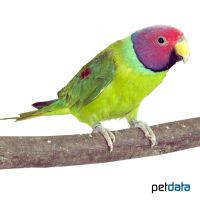Plum-headed Parakeet (Psittacula cyanocephala)
| Plum-headed Parakeet Psittacula cyanocephala | |
|---|---|
| Name | Plum-headed Parakeet |
| Name Lat. | Psittacula cyanocephala |
| Family | Elegant Parrots |
| Family lat. | Psittaculidae |
| Order | Parrots |
| Order lat. | Psittaciformes |
| Origin | Asia |
| Climate | Subtropical - tropical |
| Diet | Large Parakeet seed, veggies, fruits |
| Keeping | Pair, group |
| Care Level | Moderate |
| Reproduction | Cavity nest |
| Life Span | 20 years |
| Protection | CITES Appendix II; EC Annex B |
| Metric Units | |
| Size | 37 cm |
| Temperature | Room temperature |
| Housing | 200 x 100 x 100 cm |
| US Units | |
| Size | 15" |
| Temperature | Room temperature |
| Housing | 80" x 40" x 40" |
Distribution and habitat
Plum-headed parakeets are widespread from western Pakistan through India and southern Nepal to Bangladesh and Sri Lanka. They live in mountain forests, parks and cultivated land up to 1,600 m altitude. They are bred in many color mutations.
Cage size
The minimum cage size is 200 x 100 x 100 cm (L x W x H) for a pair. The cage size must not be undercut even in case of justified single keeping. For an additional 2 birds, assuming species compatibility, the floor space must be increased by 50%. The cage must be placed at a height of at least 80 cm (except aviaries) in a bright, draught-free and quiet place and should have cross-wiring or netting. Keeping in an aviary with a floor area of at least 3 m² is preferable to keeping in a cage.
Maintenance
The floor must be covered with sand, shavings of untreated wood or similar material and cleaned once a week if possible. At least 2 perches made of wood or branches of different thickness and height are to be installed in such a way that the longest possible flight path is created. They need a bathing opportunity and should also be sprayed with water occasionally (e.g. sprinkler system). Rings, ropes, and natural branches that are not harmful to health should be offered for occupation. They should be kept at room temperature.
Diet
The species-specific food offer consists of mixed seeds, available in specialized trade as "large parakeet food" in premium quality, supplemented with foxtail millet, green food (dandelion, chickweed, green panicle millet), vegetables (carrots etc.), fruit, (apples etc.), berries (firethorn, rowan), occasionally insect food and especially for the rearing of young sprouted seeds.), fruit, (apples, etc.), berries (firethorn, rowan), fresh twigs with buds, occasional insect food and, especially for raising young, germinated seed (wheat, corn), mealybug larvae and egg food. If there are several animals, set up several feeding stations. They need grit, cuttlefish and vitamin lime as digestive aids. Drinking water must always be available in birdbaths or in stable, open containers and, like food, must be offered fresh daily in clean containers.
A varied diet promotes health and prevents deficiency symptoms.
Reproduction and breeding
The male has a plum-colored head and an orange-yellow upper bill. In the female, the head is gray and the upper bill is pale yellow. They breed in nest cavities made of softwood or in hollowed tree trunks. Bark mulch or sawdust from conifers is suitable as nest box bedding. The clutch consists of 4-6 eggs, the brood duration is 24 days. The incubation period is, biologically speaking, from March to August when the birds are kept in open-air aviaries. Young birds must be raised so that they are species-specific. The average life expectancy can be 20 years.
Species protection
They must be identified in accordance with Appendix 6 of the Federal Species Protection Ordinance. The animal population must be reported to the competent authority in writing immediately after the start of keeping
Species protection: WA Appendix II; EU Appendix B. The proof of purchase is the required proof of origin for the animal. Please keep it safe! Your pet store will be happy to provide you with further information.
Important
They may only be kept in pairs or groups. During the breeding season, they can also be kept in pairs
In the case of outdoor aviaries, they also need a heated shelter of at least 1 m², which can be visited by the birds at any time. The temperature in the shelter must not fall below 5 °C and the furnishings must be the same as those used for caging
Sufficient daylight or flicker-free artificial light (stroboscopic effect) corresponding to daylight must be provided in rooms, including the shelters. The lighting duration shall be 8-12 hours per day and the natural day-night rhythm shall be respected. Adequate indoor climate should be provided. If caged, they should be allowed free flight. The health condition of the birds should be checked daily
Further literature can be found in your pet store.
References
Text: petdata; Image: petdata
Source: BMELV (1995): Tierschutzgutachten - Mindestanforderungen an die Haltung von Papageien; ARNDT (1997): Lexikon der Papageien, Arndt-Verlag; GRUMMT & STREHLOW (2009): Zootierhaltung - Tiere in menschlicher Obhut: Vögel, Verlag Harri Deutsch
- Gemäß § 21 Abs. 5 Tierschutzgesetz idgF
